Oregano plant care is easy if you choose an area in part shade or full sun, space the plants 12 inches apart and make sure you plant in well draining soil. Allow the Oregano to dry out between watering and fertilize with pelleted chicken manure in Spring. Great companion plants for Oregano include Sage, Rosemary and Thyme.
| Plant type | Herb |
| Plant size | 30 inches high, up to 20 inches wide |
| Main varieties | Common oregano and Spicy Oregano |
| Difficulty | Easy to grow |
| Cost | Affordable (around $5 for a seedling). |
| Spacing | Space plants at least 12 inches apart. |
| Where to plant | Full sun or part shade. |
| Soil type | Well-draining soil that is rich with organic matter. |
| Watering | Let oregano dry out between watering. Test to see if the soil is damp 1 inch below the soil before giving them more water. |
| Fertilizer | Pelleted chicken manure applied in Spring |
| Best way to grow | From seedling and division. |
| Growth type | Grows all year round as a ground cover. |
| Container growing | Grows well in containers and raised garden beds. Choose a pot that is 1-2 inches larger than the oregano and transplant to a larger pot as it grows. |
| Companion plants | Chives, rosemary, sage, citrus, strawberries and raspberries. |
| HarvestingTrim tips using kitchen scissors. Cut around 3-4 inch stems. | |
| Dividing | Split larger oregano plants by taking pieces with healthy root systems and replanting. |
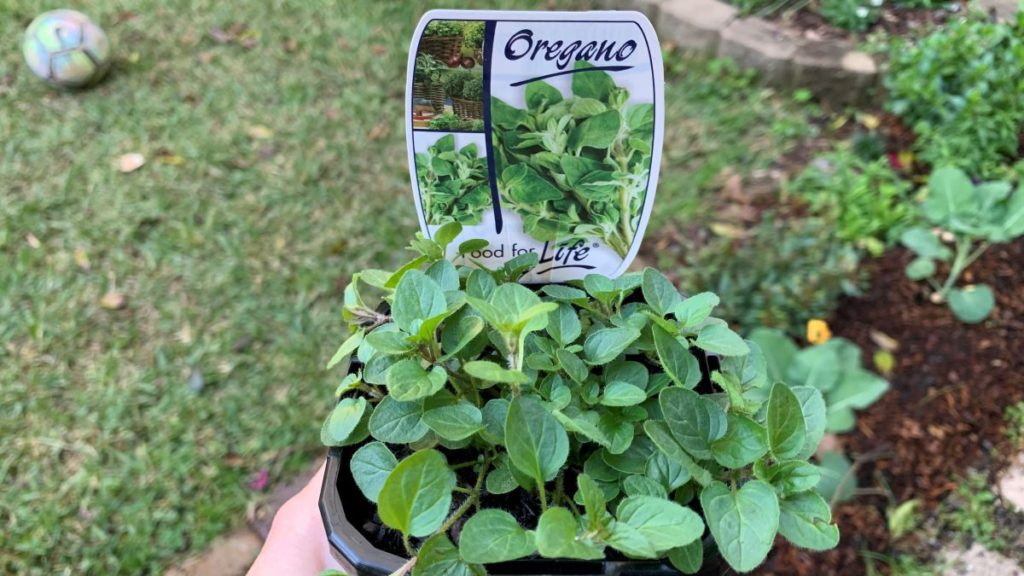
How to grow oregano: Step by step
Growing oregano by seedling is the best and easiest way to get a healthy plant growing quick in your garden. Here is my step by step guide.
- Choose a sunny or part shade spot in your garden that is at least 10 inches wide.
- Rake back any mulch on your soil.
- Add a handful of pelleted chicken manure, compost or worm castings to the soil.
- Dig the fertilizer through gently with a small fork or spade into the top 5 inches of soil.
- Make a small hole the size of the pot in the soil and place the extra soil into a spare pot or bucket.
- Remove the plant from the pot and place it in the hole.
- Backfill the plant with soil removed, place any excess soil in another garden bed or in your worm farm.
- Put the mulch back around the plant.
- Water in well to settle the soil around the plant roots.
The organic fertilizer you dig into the soil will feed the plant for up to year. You will only need to add extra pelleted chicken manure, compost or worm castings once per year as the oregano are not hungry plants.
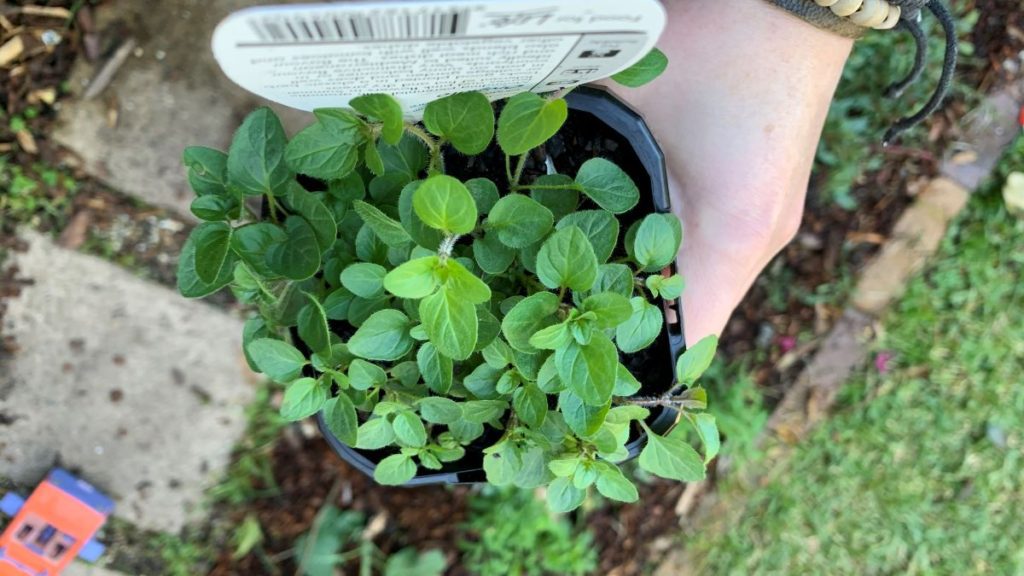
Oregano – Key Facts
Oregano likes dryer, lower nutrient soils and have been used as a herb in kitchens for many years. It is commonly used in Greek and Italian foods like:
- Pizza
- Pasta
- Roast lamb
- Roast vegetables
Plant type
Oregano is a herb which means the leaves and stems can be used in cooking. The best way to use it is to cut stems and leave them to dry in a cool, dry area. Cut stems to 3-4 inches long, tie them together with natural string and hang them upside down.
In 1-2 months they will have dried completely and can be crushed and used in cooking.
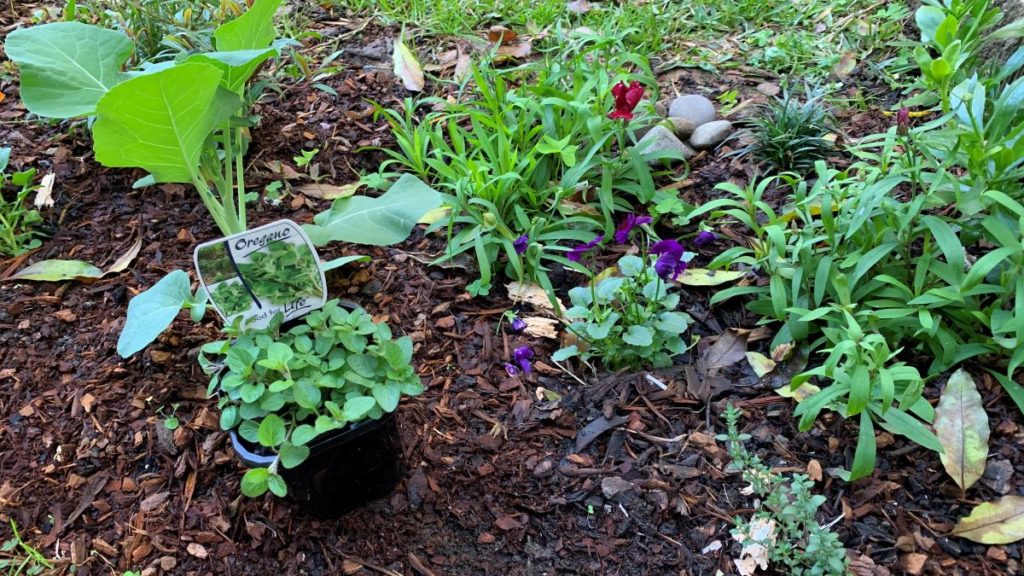
Oregano Varieties
The two main varieties of Oregano that are easy to find are:
- Common Oregano
- Spicy Oregano
Common Oregano will have a mild flavor while the Spicy Oregano will have a stronger flavor so you will need to add less to cooking to get that true oregano taste.
I have chosen the Common Oregano as I want to use it mainly as a groundcover and prefer a mild taste.

Cost
Oregano is an affordable herb and a small seedling can lost less than $5. As your oregano grows you can lift and divide it and over time you can get many plants from one purchase.
You can buy oregano and grow it by seed which will be a cheaper option. If you only want 1 Oregano plant it is easier and more reliable to buy one seedling to start you off. As the plant grows you can lift and divide the plant to give you more.
Oregano Plant Spacing
Space your oregano plants at least 12 inches apart and give them a 6 inch gap between other plants. This will give them the space to spread. If you want to keep your plant smaller, trim it regularly. Oregano plants grow really well when trimmed regularly.
Where to plant
Plant your oregano in full sun or part shade. When they are grown in full sun the flavor in the leaves will be slightly stronger. Oregano will still grow well in part shade.

Soil type and fertilizer
Grow oregano in well-draining soil that is rich with organic matter. Oregano is not a heavy feeder so you do not need extremely nutrient rich soil. I have always found that oregano will grow better if you add extra organic matter to the soil before planting.
Home-made compost, aged cow manure, worm castings or a handful of pelleted chicken manure are great for oregano. Mix together with the soil that you remove when digging the hole for the plant.
You can backfill the plant with the soil and add any extra to your worm farm or as a top dressing around other plants in your garden.
You will only need to fertilize your oregano once per year with an organic fertilizer like pelleted chicken manure. Fertilize in spring when the oregano will be growing faster as the weather warms. You can also top dress with a well-aged compost and nutrients will be washed down to the plant roots when it rains.
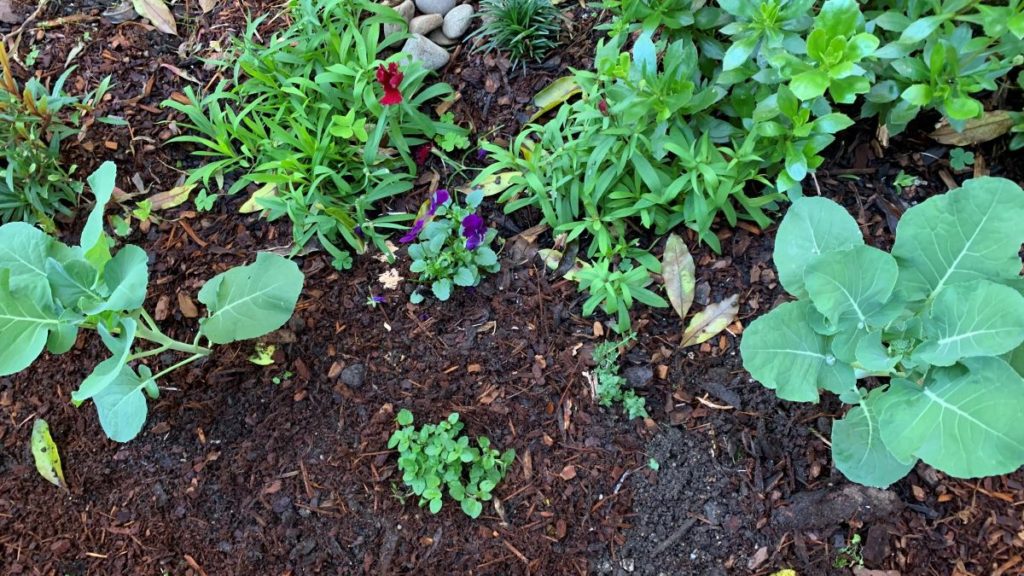
Watering
Oregano is a Mediterranean herb so let it dry out between watering and always test the soil before watering again. If the soil is damp 1 inch below the soil then you can leave them another day or two before watering.
I had a large oregano plant when I was growing my vegetable garden in the Barossa Valley. The dry Mediterranean weather suited the oregano perfectly and it was the one plant in my vegetable garden that would still survive if I forgot to water.
I had divided my oregano into 10 pieces and planted it as a ground cover between my vegetable garden beds. It helped to keep the weeds down and would smell delicious when I would step on it.
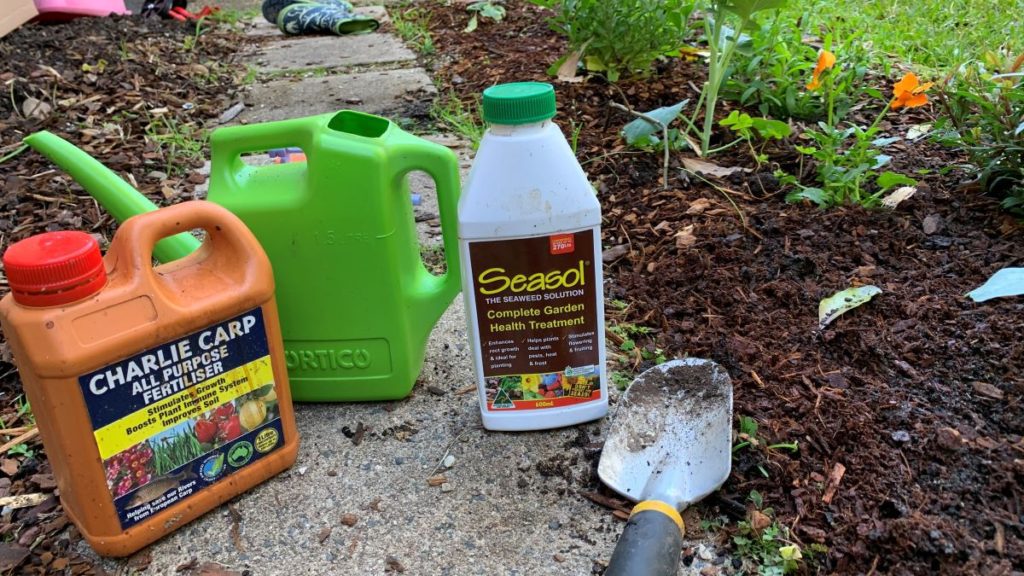
Growing Oregano from seedlings
Grow oregano easily from seedling or small plants bought from a garden center. This is the easiest and most reliable way to get a successful plant. You can also divide larger plants as they grow by lifting them from the soil and splitting the plant and roots.
Simple steps to divide Oregano
- Wait until the plant is at least 3-4 inches across.
- Dig the plant out of the ground.
- Use a sharp spade to split the plant in two or more pieces. Make sure there is a strong root system attached to each piece.
- Replant each piece in your garden, pot or raised garden bed.
- Water each plant in well.
Oregano growth
Oregano grows all year round as a ground cover. It can grow to around 30 inches high and up to 20 inches wide but it can be kept smaller if you keep trimming it back. Let your oregano ramble across your garden or lift and divide it once it has outgrown its space.

Container growing
Oregano will grow well in containers if you choose a good quality potting soil. Choose a pot that is 1 size bigger than the pot that it came in so the roots don’t become to cold or wet in a large pot. Oregano can then be transplanted to larger pots as it grows.
Plant Oregano with other Mediterranean herbs like Sage, Thyme, Rosemary and Marjoram. You can let your Oregano grow over the edges of the pot and ramble down the side. Oregano looks great as a feature in your backyard or plant it with other culinary herbs for a portable, edible garden.
Companion plants
- Chives
- Rosemary
- Sage
- Citrus
- Strawberries
- Raspberries.
I also love to plant small oregano plants near my tomatoes in summer because they work perfectly together in cooking. Oregano is a great companion to other Mediterranean herbs like Rosemary and Thyme as they all like to same soil conditions, fertilizer and watering.
Harvesting
Trim the tips of oregano around 3-4 inches down the stem using kitchen scissors or garden secateurs. You can strip the leaves off the stems to use them fresh in cooking or hang the stems upside-down with string to dry.
If you are not using your oregano in your kitchen you should still give it a trim to keep the plant compact. Trim oregano in the Spring growing season to keep it growing new soft stems.
Oregano Plant Care – Summary
Oregano is an easy plant to grow and is great in your garden and in cooking. They are a cheap plant that will grow quickly so you can divide to transplant new plants in your garden for free or give them away to friends.
Happy planting.
I am an accredited practicing dietitian, experienced gardener and a dedicated cook. I love writing and sharing my experience so you can learn from my successes and mistakes.
